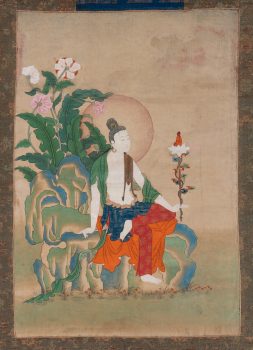Kham Province, Eastern Tibet
19th century



Kham Province, Eastern Tibet
19th century



This depiction of the Bodhisattva of Compassion, Avalokiteshvara, does not follow the usual Indo-Tibetan textual descriptions of the deity, demonstrating a degree of artistic freedom in the representation. The figure is casually seated and meditatively gazing at the small red figure of Buddha Amitabha, his spiritual father, sitting on a lotus.The great Tibetan artist and patron Situ Panchen (1700–1774) set up a workshop of artists in 1732 to paint a set of the Eight Great Bodhisattvas, upon which this painting is based. He had the artist Thrinlay Rabphel of Karsho, near Karma Monastery in Kham, trace and sketch older paintings by Konchok Phende, a prominent sixteenth-century court painter of the ninth Karmapa. Not only does this set indicate what kind of models Situ selected in his revival of the Encampment painting style, but it also bears witness to the existence of strong Chinese figural and compositional elements in earlier pre-Encampment style paintings from the court of the Ninth Karmapa in the sixteenth century.
In Buddhism merit is accumulated through engaging in positive actions that lead to positive results, such as better rebirths. Buddhists gain merit by making offerings, donating to those in need, reciting mantras, and other good deeds.
A meditation technique primarily used in tantric practice that involves imagining a deity in one’s mind or imagining oneself becoming a deity and carrying out various activities. Such techniques are intended to help a practitioner transform ordinary perception and achieve enlightened qualities.
The cultivation of a strong aspiration to help sentient beings overcome suffering. In Buddhist Mahayana teaching, compassion is the seed for attaining full enlightenment.
Beings who aspire to become fully awakened like the Buddha and are dedicated to helping others on the path to enlightenment.
Today, Tibetans primarily inhabit the Tibetan Plateau, situated between the Himalayan mountain range and the Indian subcontinent to the west, Chinese cultural regions to the east, and Mongolian cultural regions to the northeast. During the 7th to 9th century, Tibetan rulers expanded their empire across Central Asia, and established Buddhism as the state religion.
Get the latest news and stories from the Rubin, plus occasional information on how to support our work.